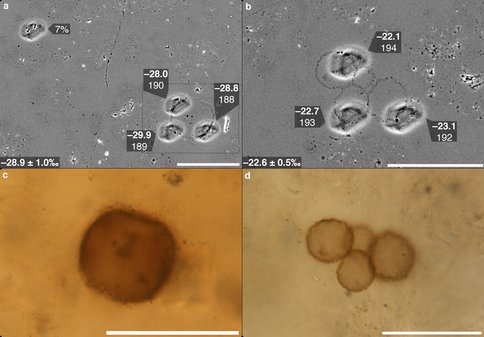2013 Annual Science Report
 University of Wisconsin
Reporting | SEP 2012 – AUG 2013
University of Wisconsin
Reporting | SEP 2012 – AUG 2013
Project 3C: Carbon Isotope Analysis of Proterozoic Microfossils
Project Summary
We have developed procedures for accurate in situ analysis of carbon isotope ratios by SIMS for individual Precambrian microfossils of unquestioned biogenicity. Data for three Proterozoic localities show a consistent fractionation of 19 per mil between organic matter and coexisting carbonates, in spite of over 6 per mil variability from rock to rock, consistent with fractionations seen for modern cyanobacteria. In one sample, a phytoplanktonic protistan acritarch, found within the same mm-scale domains, are 6 per mil more fractionated, consistent with photosynthetic eukaryotes. These findings show for the first time the possibility of using in situ isotopic microanalysis of fossil microbial mats and ancient sediments in order to distinguish metabolic fingerprints within complex microbial ecosystems and consortia.
Project Progress
We have developed techniques for in situ carbon isotope (δ13C) analysis of Precambrian permineralized microscopic fossils with a reproducibility of 1–2‰ using secondary ion mass spectrometry (SIMS). Individual microfossils, selected for their excellent preservation, were analyzed in petrographic thin sections of stromatolitic cherts from the Proterozoic Gunflint (1880 Ma), Bitter Springs (830 Ma), Min’yar (740 Ma), and Chichkan (775 Ma) Formations. The range of δ13C values (-34.6 to -22.1‰ VPDB) among the 46 individuals analyzed falls within that expected for photoautotrophic carbon fixation by ribulose bisphosphate carboxylase (RuBisCO), consistent with morphology-based taxonomic assignments for these specimens. Microfossils classified as cyanobacteria from the Gunflint, Bitter Springs, and Min’yar Formations (for which published carbonate carbon isotope data can be used to estimate the δ13C of the original dissolved inorganic carbon substrate) exhibit a consistent ~19‰ total fractionation (δ13C of dissolved inorganic carbon – δ13C of biomass) similar to that observed in living cyanobacteria, over a wide range of δ13C(carb) values (-2.9 to 3.4‰). In stromatolitic chert of the Min’yar Formation, morphologically diverse microfossils preserved in a ~1 mm2 part of a microbial mat exhibit systematic isotopic differences among and within taxa that correlate with their morphologically inferred biological affinities and suggest that isotopic signatures of their original biosynthetic processes (e.g., lipid and peptidoglycan synthesis) are preserved. Isotopic offsets consistent with the different RuBisCO-based fractionations typical of cyanobacteria and photosynthetic eukaryotes are documented by the differing δ13C values of a colonial cyanobacterium (-22.6 ± 0.5‰) and a phytoplanktonic protistan acritarch (-28.9 ± 1.0‰) situated <1 cm apart in the stromatolitic Chichkan chert. These findings show for the first time the possibility of using in situ isotopic microanalysis of fossil microbial mats and ancient sediments in order to distinguish metabolic fingerprints within complex microbial ecosystems and consortia, and to test the genesis of carbonaceous matter in samples where a biological origin is questioned.
Publications
-
Lepot, K., Williford, K. H., Ushikubo, T., Sugitani, K., Mimura, K., Spicuzza, M. J., & Valley, J. W. (2013). Texture-specific isotopic compositions in 3.4Gyr old organic matter support selective preservation in cell-like structures. Geochimica et Cosmochimica Acta, 112, 66–86. doi:10.1016/j.gca.2013.03.004
-
Williford, K. H., Ushikubo, T., Schopf, J. W., Lepot, K., Kitajima, K., & Valley, J. W. (2013). Preservation and detection of microstructural and taxonomic correlations in the carbon isotopic compositions of individual Precambrian microfossils. Geochimica et Cosmochimica Acta, 104, 165–182. doi:10.1016/j.gca.2012.11.005
-
PROJECT INVESTIGATORS:
-
PROJECT MEMBERS:
James Schopf
Co-Investigator
John Valley
Co-Investigator
Martin Van Kranendonk
Co-Investigator
Kenneth Williford
Co-Investigator
Noriko Kita
Collaborator
Kouki Kitajima
Collaborator
Reinhard Kozdon
Collaborator
Navot Morag
Collaborator
Takayuki Ushikubo
Collaborator
-
RELATED OBJECTIVES:
Objective 2.1
Mars exploration.
Objective 4.1
Earth's early biosphere.
Objective 4.2
Production of complex life.
Objective 5.2
Co-evolution of microbial communities
Objective 7.2
Biosignatures to be sought in nearby planetary systems
